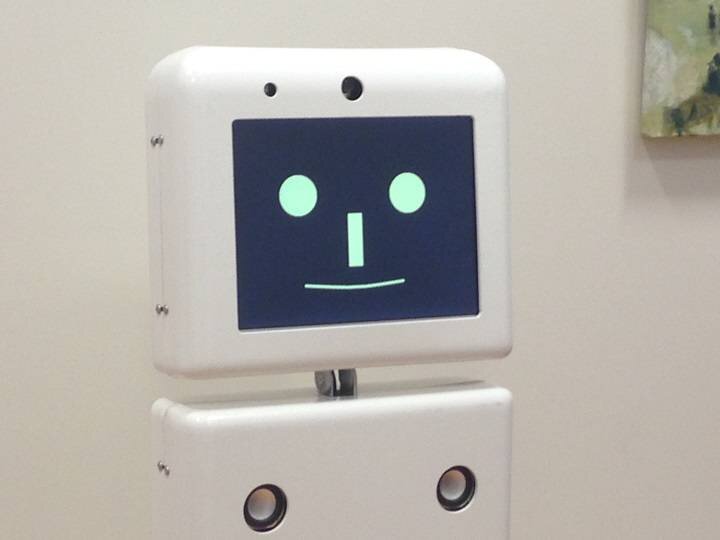How a robot could help your family member with dementia
by Allison Vuchnich for Global News:
Senior care is going hi-tech. With an aging population, researchers and health care providers are now looking to robots to ease the symptoms of dementia and help an aging population stay where they would like – at home.
With its big eyes and soft fur, Paro is a hit with the seniors holding it. The therapeutic robot was modeled after a Canadian harp seal pup.
Although it looks like a cuddly toy, this is a robot designed to have a calming and psychological effect on those who interact with it.
“Paro is really built on the same principle as pet therapy. The idea that if you care for something that looks appealing and looks needy, there is an immediate benefit to one’s psyche,” said Dr. Simon Davies, a psychiatrist and clinician-scientist, at the Centre for Addiction and Mental Health (CAMH).
Dr. Davies and his team thought Paro would be helpful as a treatment option at CAMH, so he applied for a grant. The staff at CAMH has found Paro to be helpful for those suffering from depression and an effective alternative for clients in the geriatric mental health program.
Paro, considered a companion robot, was developed by Dr. Takanori Shibata, a chief senior scientist at Japan’s National Institute of Advanced Industrial Science and Technology. Paro is registered with the U.S. Food and Drug Administration as a medical device, and its impacts have been studied, including in dementia patients.
People suffering from dementia can sometimes behave aggressively – either verbally or physically. Paro can be comforting therapy, according to researchers.
At a long-term care facility in Montreal, Paro was so successful at helping the residents that the staff raised money to help purchase a second one.
“[Paro] has a very calming effect with the residents and the robot helps us to interact with the people on the floors,” Montreal recreologist Nadine Leger, from CSSS de Saint-Léonard et Saint-Michel, told Global News.
Paro has a variety of sensors which allows it to feel and react to touch, light, audio, temperature and even sense how it is being held and touched.
According to its creator, the robotic seal’s artificial intelligence means it can remember how it was treated, for example, it has a “kind of a sad cry, a negative reaction” if it’s hit or mistreated, said Shibata.
“Paro changes his character depending on the interaction with the owner,” he added.
In Montreal, they find being able to use Paro at any time is very helpful
“He is in our centre all the time so we can use it either the day or during the daytime,” said Leger.
Helping seniors with dementia to stay at home
At an apartment in downtown Toronto, researchers are busy developing and testing solutions for seniors. Although it has the comforts of home, this is actually a lab. It’s called the Home Lab and it is part of the iDAFT Centre for Rehabilitation Research at Toronto Rehabilitation Institute a cutting edge centre.
“So this is our simulated house and essentially this allows us to develop technologies, to test technologies in a more realistic environment. It’s really almost kind of the springboard before we actually get out to the community, into the real world,” Alex Mihailidis, senior scientist with the Toronto Rehabilitation Institute told Global News.
 Here “Ed the Robot” was developed and tested as one strategy to help seniors with dementia.
Here “Ed the Robot” was developed and tested as one strategy to help seniors with dementia.
“So, Ed the Robot is really focused on helping older adults with dementia through the everyday tasks we all need to complete. Giving them the prompts, the reminders and the guidance to do common things such as getting dressed, washing their hands, brushing their teeth, making a simple meal,” said Mihailidis.
Robots can repeat tasks over and over, something that can be exhausting for a family member or caregiver.
Ed was tested in the Home Lab with older adults with dementia and their caregivers. Mihailidis said the seniors reacted very well to Ed, they followed his prompting and responded well.
“They would speak to it, they would try to actually, you know, give it a bit of character. They would say to us things like, ‘oh he really should have a hat or maybe a sweater on him to give him some personality,’” said Mihailidis. “So overall it was actually a very positive response that we found.”
Mihailidis said robots can help with the “wicked problems of dementia” – the problems that are mundane but very important.
According to the Alzheimer Society of Canada, in 2011, close to 747,000 Canadians were living with Alzheimer’s disease and other forms of dementia. The number is projected to rise to 1.4 million by 2031.
Technology can help keep older adults with dementia at home using robotics, artificial intelligence and smart-home systems that can adapt to help the senior as their needs change. For example, technology can detect if a senior has fallen and send for help.
Mihailidis is also the Scientific Director of AGE-WELL (Aging Gracefully across Environments using Technology to Support Wellness, Engagement and Long Life NCE Inc.), a national research network focused on technology and solutions to assist Canadian seniors.
“This is over 120 researchers, close to 200 trainees, over a hundred different industry and community partners all working together now really to achieve the goal of developing technologies that will be out there in the marketplace and to support older adults with dementia, and even older adults without dementia as well.”
Source: http://bit.ly/1N2s7dU

